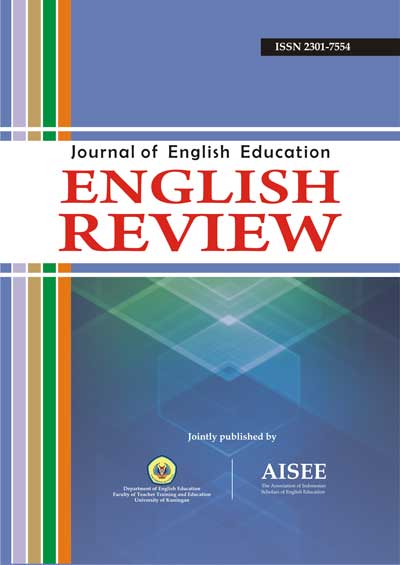AUDIENCE AWARENESS IN THE WRITTEN DISCOURSE OF SUDANESE EFL UNIVERSITY LEARNERS
Abstract
Abstract: The study investigates the written discourse of the Sudanese EFL university learners to evaluate and assess their awareness of the audience to whom they write. The analytic descriptive approach is adopted to achieve the aims of the study. The subjects of the study consisted of 50 Sudanese EFL students drawn from Faculty of Arts at Alneelain university. Three tools were employed for data collection: a writing test, a questionnaire  and an interview with the students. Results showed that the written discourse  produced by Sudanese EFL students did not reveal an awareness of the audience with whom they communicate. The students did not succeed to make assumptions of what their audience already know and what they expect to find in the texts being written. They held fragmentary knowledge on the concept of audience awareness. Accordingly, the students were not able to prepare and edit texts which keep and stimulate their audience – they were not able to depend on lexical and structural variation to produce proper and effective writing. Furthermore, results indicated that students were not able to attach unity and coherence to the texts they produced. Their organizational skills were very poor. To help the students develop the concept they hold on audience awareness, writing instructors and syllabus designers need to put special emphasis on the importance of audience awareness as a factor which is essential for effective writing.
Â
Keywords: audience awareness, communicative setting, language proficiency, discourse competence
References
Bereiter, C. & Scardamalia, M. (1987). The psychology of written composition. Hillsdale: Erlbaum
Barnet, S., Bedau, H. (Eds.) (1993). Current issues and enduring questions. Boston: Bedford Books.
Britton, J. (1975). The development of writing abilities (11 – 18), Schools Council Research Studies. London: Macmillan.
Bull, S., & Shurville, S. (1999). Cooperative writer modeling: facilitating reader-based writing with SCRAWL. In R. Morales, H. Pain, S. Bull & J. Kay (Eds.), Proceedings of workshop on Open, Interactive and other Overt Approaches to Learner Modeling, International Conference on Artificial Intelligence in Education (pp. 1-8). Retrieved from http://www.eee.bham.ac.uk/bull/papers-pdf/AIED99-WS-scrawl.pdf.
Chang, F. (2005) Audience Strategies Used by EFL College Writers. Journal of Pan-Pacific Association of Applied Linguistics (PAAL), 9, 2, 209-225. ISSN, 1345 – 8353.
Cooper, M. (1999). Ecology of Writing in Marilyn M. Cooper and Michael Holzman (Eds), Writing as Social Action (pp. 1-19) Portsmouth. NH: Boyton.
Edwin, L. & Grundy, P. (1996). Writing about writing: Teaching the process and achieving a product. Asian Journal of English Language Teaching, 6, 45-60.
Faigley, L. (1986) Connecting theories of process: A critique and a proposal. College Composition and Communication 46: 527-42.
Fountaine, S. (1988). Using what they Know: 9-, 13-, and 18- Year-olds Writing for Different Audiences. In B. Rafth & D. Rubin (Eds.) The Social Construction of Written Communication (pp. 99 – 116). Norwood, NJ: Albex Publishing Corp.
Grabe, W. & Kaplan, R. (1996). Theory and practice of writing: An applied linguistics perspective. London: Longman.
Hedge, T. (1988). Writing. Oxford: Oxford University Press.
Hinds, J. (1987). Reader versus writer responsibility: A new typology. In U. Connor and R. Kaplan (Eds), Writing across languages: Analysis of L2 text (pp. 141-152). Reading, MA: Addison-Wesley.
Hyland, K. (2003). Second language writing. Cambridge: Cambridge University Press.
Liberman, I. & Liberman, A. (1990). Whole word vs. code emphasis: Underlying assumptions and their implications for reading instruction. Bulletin of the Orton Society, 40, 51-76.
Witte, S. (1992) Context, Text, Intertext: Towards a Constructivist Semiotic of Writing. Written Communication 32, 189-204.
Wildeman, J. (1988). Defining audience negatively: One way the writers keep readers from their texts. Paper presented at the 39th Annual Meeting of the Conference on College Composition and Communication pp.4
Zakaria, A. (2013) An Assessment of the Written Performance of Sudanese EFL Learners: A Communicative Approach to Writing. World Journal of English Language; Dec2013, Vol. 3 Issue 4, p1
Zemach, D., & Islam, C. (2006). Writing in Paragraphs. MacMillan.
All articles published in English Review: Journal of English Education (ERJEE) are licensed under the Creative Commons Attribution 4.0 International License (CC BY 4.0).
Copyright Ownership
Authors retain the copyright of their articles and grant ERJEE the right of first publication. The journal is granted a non-exclusive license to publish, reproduce, and distribute the article in any format, medium, or platform, provided that proper credit is given to the original authors.
License Terms – CC BY 4.0
Under the Creative Commons Attribution 4.0 International License, others are free to:
- Share — copy and redistribute the material in any medium or format
- Adapt — remix, transform, and build upon the material for any purpose, even commercially
As long as they:
- Provide appropriate credit to the original author(s) and source
- Provide a link to the license (https://creativecommons.org/licenses/by/4.0/)
- Indicate if any changes were made
There are no restrictions on the reuse, reproduction, or adaptation of published articles as long as attribution is properly given.
Author Warranties
By submitting a manuscript to ERJEE, authors confirm that:
- The work is original and does not infringe any existing copyright.
- The manuscript has not been previously published and is not under consideration elsewhere.
- All sources and references are appropriately acknowledged.
- Necessary permissions have been obtained for any copyrighted materials used.










